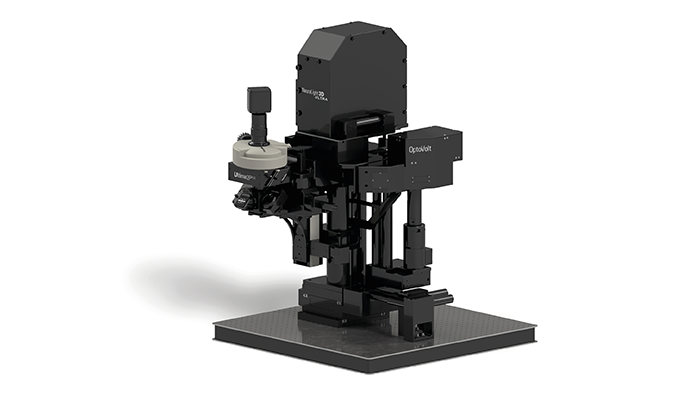
A multiphoton microscopy module that enables millisecond neural event imaging at single neuron resolution
Produced by Bruker Corporation
OptoVolt enables imaging at over 1000 frames per second, capturing millisecond-scale neural communication dynamics. Optimized for fluorescent voltage indicators, it offers the temporal precision and signal-to-noise ratio required to detect individual neural events.
When combined with Bruker’s NeuraLight 3D Ultra spatial light modulator, OptoVolt allows researchers to explore neural input-output relationships with exceptional temporal and spatial resolution, advancing the study of complex neural networks.
What the judges say…
“Characterization of single neurons – an important step to enable organ-on-chip and cell single analysis.”
“A breakthrough in neurological measurement technology.”
“A breakthrough in rapid live neuronal interaction imaging.”
Meet the Expert
We speak with Jimmy Fong, who leads the technology and product development team at Bruker for its multiphoton microscopes.
What impact could your innovation have?
The hope is that this module will allow neuroscientists to study neural communication with a temporal resolution, which has been difficult in the past. Electrophysiological tools have been the gold standard for measuring fast neural events, but it has been difficult to capture activity from many cells simultaneously. Scientists have recently developed new fluorescent indicators that allow for studying fast voltage activity of many cells and hopefully in combination with imaging instruments like the OptoVolt, can help unlock the mysteries of brain function and dysfunction.
Was there a key breakthrough or major “eureka” moment during development?
We recently released a new module for our microscope that enables unprecedented scan speeds at more than 1000 images per second. The neuroscience community is especially excited for this module that we call OptoVolt, because it allows for imaging neural events that only last for a few milliseconds.
In developing the OptoVolt module, there were a few moments that were critical: 1) recognizing that there existed a new invention from Boston University researchers that could be adapted for this purpose and 2) actually seeing the millisecond “blips” of neural activity of a live animal imaged at 1000 frames per second for the first time!
Did you collaborate with any external teams during development?
Much of the credit goes to the inventors of the core technology at Boston University and the collaboration and licensing of the technique crucial to the development of our imaging system. Commercializing and creating a product from prototypes has its own challenges where the focus is on usability, reliability, and manufacturability, but the product would not exist without the partnership.
Do you have a “philosophy of innovation”?
One philosophy that has worked recently for us has been the idea of “failing fast.” There will be a lot of things that you try that do not work, and the faster that you can obtain that information, the more quickly you can get to something that will. This often means prototyping several concepts in parallel or getting multiple opinions from different sources.
Are you driven more by scientific curiosity or the desire to make an impact?
A bit of both – many on our team come from a scientific or engineering background, so they have a thirst for understanding. We recognize and appreciate the impact that our customers have in improving healthcare and are happy to be a part of it.
Is there anything missing from the analytical scientist’s toolbox today?
Handling large data is a focus of many industries and in bioimaging, it is no different. With advanced microscopy techniques, scientists can generate enormous amounts of data, which is becoming a problem for the process of storing, analyzing and deriving conclusions. Improved data handling tools are necessary for continued progress.
What big problems could analytical innovation help to solve over the next decade?
The problems that our team is focused on along with our academic partners are related to understanding brain function. We provide advanced imaging workstations to our customers so they can study the big questions of how memories are formed, how visual scenes are computed, how Alzheimer’s disease affects neural computation, and others.
What’s next for your team?
As developers of imaging instrumentation, we are always looking at how we can improve imaging quality to be faster, deeper, with higher resolution. In addition, we strive to make our tools easier to use and more accessible to the scientific community. We hope that better tools in the hands of scientists can help lead to more impactful discoveries.




